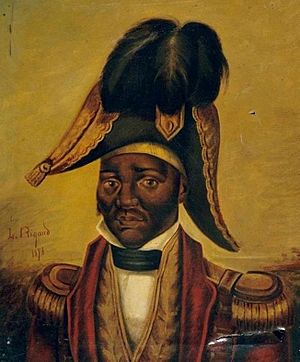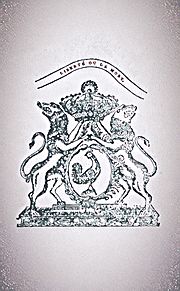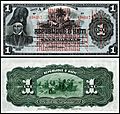Jean-Jacques Dessalines facts for kids
Quick facts for kids Jacques I |
|||||
|---|---|---|---|---|---|

portrait of Dessalines, c. 1840–1880
|
|||||
| Emperor of Haiti | |||||
| Reign | 2 September 1804 – 17 October 1806 | ||||
| Coronation | 8 October 1804 | ||||
| Governor-General of Haiti | |||||
| In office | 1 January 1804 – 2 September 1804 | ||||
| Born | 20 September 1758 Cormier, Grande-Rivière-du-Nord, Saint-Domingue |
||||
| Died | 17 October 1806 (aged 48) Pont Larnage (now Pont Rouge), near Port-au-Prince, Haiti |
||||
| Burial | 17 October 1806 by Dédée Bazile | ||||
| Spouse | Marie-Claire Heureuse Félicité | ||||
|
|||||
| Coat of arms |  |
||||
Jean-Jacques Dessalines (born September 20, 1758 – died October 17, 1806) was a very important leader in the Haitian Revolution. He became the first ruler of an independent Haiti. At first, he was the governor-general. Later, he was named Emperor of Haiti as Jacques I (1804–1806). He ruled until he was killed in 1806. Many people call him the father of the nation of Haiti.
Dessalines was in charge of the country. Under his rule, Haiti became the first country in the Americas to officially end slavery forever. Dessalines served as an officer in the French army. At that time, the colony was fighting off attacks from Spanish and British forces. Later, he became a top commander in the fight against France. He was a main helper to Toussaint Louverture. He led many successful battles, like the Battle of Crête-à-Pierrot.
After Toussaint Louverture was captured in 1802, Dessalines became the leader of the revolution. He led the Armée Indigène (Native Army) from May 18, 1803. He won a big victory against the French army at the Battle of Vertières on November 18, 1803. On January 1, 1804, Dessalines declared Haiti an independent nation. A group of generals chose him to be the governor-general.
In September 1804, the generals of the Haitian Revolution Army made Dessalines emperor. He ruled as Emperor Jacques I under the Constitution 1805. He was killed in 1806 by people who did not agree with his rule.
Contents
Early Life of Jean-Jacques Dessalines
Jean-Jacques Duclos was born into slavery around 1758. This happened on a plantation called Cormier. It was near Grande-Riviere-du-Nord, in a French colony called Saint-Domingue. His enslaved father got his last name from his owner, Henri Duclos. We don't know where Jean-Jacques's parents came from in Africa. Most enslaved people brought to Saint-Domingue came from West and Central West Africa.
Later, Jean-Jacques was bought by a free man of color named Dessalines. He then took the name Jean-Jacques Dessalines. He kept this name even after he became free. He worked in the sugarcane fields as a laborer. He rose to become a commandeur, which means a foreman. He worked on the Duclos plantation until he was about 30 years old.
When the slave uprising began in 1791, it spread across the northern plains. This area had many large sugar cane plantations. Many enslaved Africans lived and worked there. Dessalines learned early military skills from a woman named Victoria Montou or Akbaraya Tòya.
During the revolution, Dessalines became very angry. He was upset with both the white colonists and the mixed-race residents. Haitian fighters fought against French, British, and Spanish forces. These European nations had colonies in the Caribbean. Their control and money were threatened by the Haitian Revolution.
After the French forces were pushed out, Dessalines ordered that remaining white people be killed. This was to make sure Haiti stayed a free nation. Many mixed-race people were also killed. However, after becoming Governor-for-Life in 1804, Dessalines took his old master, Dessalines, into his home and gave him a job.
Dessalines's Family Life
Dessalines was married to Marie-Claire Heureuse Félicité Bonheur. She was from the city of Léogane. Their wedding was held in St-Marc Church. Toussaint Louverture was a witness. Marie-Claire became empress under the 1805 Constitution. She is known for creating the soup lendepandans, or Pumpkin Independence Soup. This soup is now a UNESCO heritage item.
Marie-Claire was older than her husband. She lived to be 100 years old. After Dessalines was killed, she was called the "adopted wife of the Nation." The couple had or adopted 16 children. This included Jacques's children from earlier relationships. One of his sons, Innocent, has a fort named after him.
Euphémie Daguile was one of his well-known partners. She created the Karabiyen dance. This dance is also called Jacques's favorite dance. Haitian families still dance it across the country today.
Dessalines had two brothers, Louis and Joseph Duclos. They also later took the last name Dessalines. Two of his brothers' sons became important leaders in the Haitian government after the revolution.
The Haitian Revolution
Ending Slavery in Haiti
In 1791, Jean-Jacques Dessalines joined the slave rebellion. Thousands of other enslaved people joined too. This rebellion started in the northern plains. It was led by Jean François Papillon and Georges Biassou. This was the first step of what became the Haitian Revolution. Dessalines became a lieutenant in Papillon's army. He followed him to Santo Domingo, the eastern part of the island. There, he joined Spain's military to fight against the French colony of Saint-Domingue.
During this time, Dessalines met Toussaint Bréda. He was a rising military leader, later known as Toussaint Louverture. He was also born into slavery and was fighting with Spanish forces. Both men wanted to end slavery above all else. In 1794, France ended slavery because of the French Revolution. Toussaint Louverture then changed sides and fought for the French Republic. He fought against both the Spanish and British. These countries wanted to control the rich colony of Saint-Domingue. Dessalines followed Toussaint. He became a main helper and rose to the rank of brigadier general by 1799.
Dessalines led many successful battles. These included taking over Jacmel, Petit-Goâve, Miragoâne, and Anse-à-Veau. In 1801, Dessalines quickly stopped a rebellion in the north. This rebellion was led by Louverture's nephew, General Moyse. Dessalines became known for his tough approach. He would often burn homes and whole villages.
The rebellious enslaved people gave most of Saint-Domingue back to France. Louverture was in control. The French first made him governor-general. Louverture wanted Saint-Domingue to have more freedom. He created a new constitution to set this up. It also set rules for how the colony would work under freedom. He also named himself governor-for-life. He still said he was loyal to France.
The French government had changed after their own revolution. Napoleon Bonaparte was now in charge. His wife, Josephine de Beauharnais, came from a family that owned enslaved people. Many white and mixed-race plantation owners asked the French government to bring back slavery in Saint-Domingue. Napoleon wanted to bring back slavery. He believed it was needed to grow and process the valuable sugar crops. Saint-Domingue made the most money of all French colonies before the 1791 revolution.
Fighting to Stay Free
In 1802, the French sent a large army to the island. This force was led by General Charles Leclerc. Their goal was to bring back French rule. Louverture and Dessalines fought against these French forces. Dessalines won his most famous battle against them at Crête-à-Pierrot.
During the battle on March 11, 1802, Dessalines and 1,300 of his men defended a small fort. They fought against 18,000 attackers. To inspire his soldiers, Dessalines held a lit torch near an open barrel of gunpowder. He said he would blow up the fort if the French broke through. The defenders caused many losses for the attacking army. But after a 20-day siege, they had to leave the fort. They ran out of food and ammunition. The rebels fought their way through enemy lines. They went into the Cahos Mountains, with most of their army still together.
French soldiers under Leclerc were joined by mixed-race troops. These were led by Alexandre Pétion and André Rigaud. They were free people of color from Saint-Domingue. Pétion and Rigaud had been against Louverture's leadership. They had tried to create their own independent area in the South of Saint-Domingue. This was where many wealthy mixed-race people had plantations. Toussaint Louverture's forces had defeated them three years before.
After the Battle of Crête-à-Pierrot, Dessalines briefly joined Leclerc, Pétion, and Rigaud. Some historians believe Dessalines was partly responsible for Louverture's arrest. On May 22, 1802, Dessalines learned that Louverture had not told a local rebel leader to stop fighting. Dessalines quickly wrote to Leclerc to report Louverture's actions. Because of this, Dessalines and his wife received gifts from Jean Baptiste Brunet. Louverture and about a hundred of his close followers were arrested on June 7, 1802. They were sent to France. Louverture was put in prison at Fort-de-Joux, where he died on April 7, 1803.
It became clear that the French planned to bring back slavery in Saint-Domingue. They had already done this on Guadeloupe. So, Dessalines and Pétion changed sides again in October 1802. They decided to fight against the French. By November 1802, Dessalines became the leader of the rebels. General Alexandre Pétion, a well-known free man of color, supported him. Leclerc died from yellow fever, which also killed many French troops. The harsh methods of Leclerc's replacement, Rochambeau, helped unite the rebel forces against the French.
The rebels won many battles against the French. The last major battle of the revolution was the Battle of Vertières. On November 18, 1803, black and mixed-race forces attacked the fort of Vertières. This fort was held by Rochambeau near Cap-Français. Dessalines and Pétion led these forces. Rochambeau and his troops gave up the next day. On December 4, 1803, Napoleon Bonaparte's French colonial army gave up its last land to Dessalines's forces. This officially ended the only slave rebellion in history that successfully created an independent nation.
Dessalines became one of the most successful military leaders against Napoleon's France. In 1804, Dessalines announced Haiti's independence. He then declared himself emperor.
Emperor of Independent Haiti
On January 1, 1804, in the city of Gonaïves, Dessalines officially declared the former colony's independence. He renamed it "Ayiti" after the original Taíno name. He had been Governor-General of Saint-Domingue since November 30, 1803. After declaring independence, Dessalines named himself Governor-General-for-life of Haiti. He held this role until September 22, 1804. On that day, the generals of the Haitian Revolution Army declared him Emperor of Haiti. He was crowned Emperor Jacques I in a special ceremony on October 6 in the city of Le Cap (now Cap-Haïtien). On May 20, 1805, his government released the Imperial Constitution. It named Jean-Jacques Dessalines emperor for life. It also gave him the right to choose who would rule after him.
Ending Slavery Forever
When Dessalines declared Haiti an independent country, he also ended slavery there. Haiti became the first country in the Americas to permanently abolish slavery. Dessalines tried to keep the sugar industry and plantations working. He wanted them to produce crops without slavery.
Dessalines had been enslaved by white masters for 30 years. He had also seen many terrible things. Because of this, he did not trust the white French people. Many white plantation owners and merchants had already left the island. They went to Cuba, the United States, and France as refugees. Between February and April 1804, Dessalines ordered the killing of the remaining white people in Haiti. Dessalines declared Haiti to be a nation for black people. He made it illegal for white people to own property or land there.
Haiti's Economy
Dessalines made sure that plantation work continued strictly. This was called agrarian militarism by historian Michel-Rolph Trouillot. Like Toussaint Louverture, Dessalines demanded that all black people work. They had to be either soldiers to defend the nation or laborers on plantations. This was to grow crops for export and help the nation survive. His forces were very strict about this. Some black people felt like they were enslaved again.
Dessalines also believed in controlling foreign trade very closely. This was important for Haiti's economy, which relied on sugar and coffee exports. Like Toussaint Louverture, Dessalines encouraged merchants from Britain and the United States more than those from France. For his government, Dessalines needed educated officials and managers. He put well-educated Haitians in these jobs. Most of these people were from the light-skinned elite, as they were more likely to have received an education.
Death of Emperor Dessalines
Some members of Dessalines's government were unhappy with him. These included Alexandre Pétion and Henri Christophe. They started a plan to overthrow the Emperor. Dessalines was killed north of the capital city, Port-au-Prince. This happened at a place called Larnage (now Pont-Rouge). He was on his way to fight the rebels on October 17, 1806.
His body was found by Marie-Sainte Dédé Bazile. It was buried in the Cimetière intérieur of Church Ste-Anne. Étienne Gérin's wife put up a tombstone with the words: "Here lays Dessalines, died at 48 years old." Later, his body was moved to the Autel de la Patrie (Altar of the Fatherland) in Champs-de-Mars. Alexandre Pétion's body is also there.
A monument at the northern entrance of the Haitian capital marks the place where the Emperor was killed. Dessalines's death did not solve the problems in the Haitian government. His murder left a power gap, and a civil war followed. Pétion and Christophe divided Haiti between them for a time. Pétion controlled the South, where there were more free people of color.
Dessalines's Legacy
- Several of Dessalines's relatives also held leadership roles. His nephew Raymond became a Baron and served King Henry I. Another nephew, Joseph, also became a Baron and served the Prince Royal. His grandson Florvil Hyppolite was president of Haiti from 1889 to 1896.
- In 1804, the city of Marchand was renamed Dessalines in his honor. Dessalines was the first capital of the new nation. It was also the first black capital in the new world. The city is on the north shore of the Artibonite River. It is protected by several forts.
- For much of the 1800s, Dessalines was not well-liked because of his strict rule. But by the early 1900s, people started to see him as a symbol of Haitian pride. Haiti's national anthem, "La Dessalinienne", written in 1903, is named after him.
- The Main Street in Port-au-Prince (Grande-Rue) was renamed Boulevard Jean-Jacques-Dessalines. It is the main shopping area downtown.
- The loa Ogou Dessalines is honored in the northern part of Haiti. Jacques I is the only Haitian leader honored in Haitian Vodou. This is part of the Nago family, known for its military rituals and drumming.
- Many streets, avenues, and boulevards in Haiti are named after Dessalines, Jean-Jacques, or Jacques I.
- Statues of Dessalines can be found in Port-au-Prince, Gonaïves, Cap-Haïtien, and other cities in Haiti.
- July 25 was a special day during his rule for his birthday celebration. It is also St-Jacques-Majeur patron day. It is still a Vodou pilgrimage day today in St-Jacques Bassin in the Plaine-du-Nord area.
- The coat of arms of both the Kingdom of Hayti and the Second Empire Haiti features two lions and an eagle-style bird. These were from the coat of arms of the First Empire of Hayti.
- The Haitian anthem is called "La Dessalinienne," or "Dessalines's song," in his honor.
Images for kids
-
Dessalines depicted on a 1916 Banque Nationale de la République 1 gourde note (1916)
See also
 In Spanish: Jean-Jacques Dessalines para niños
In Spanish: Jean-Jacques Dessalines para niños




